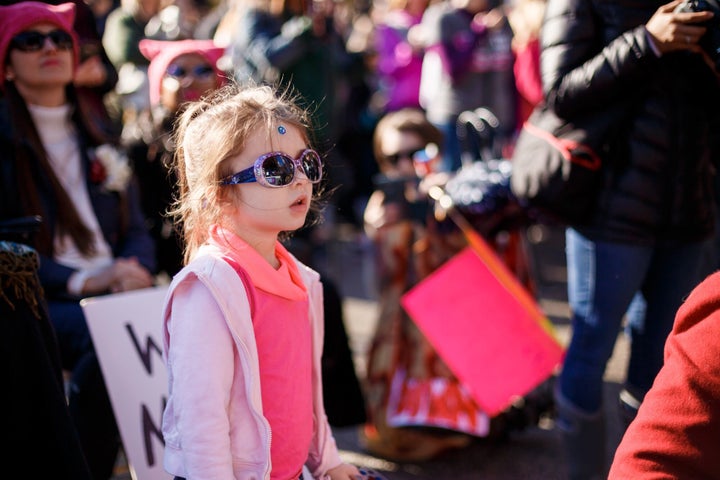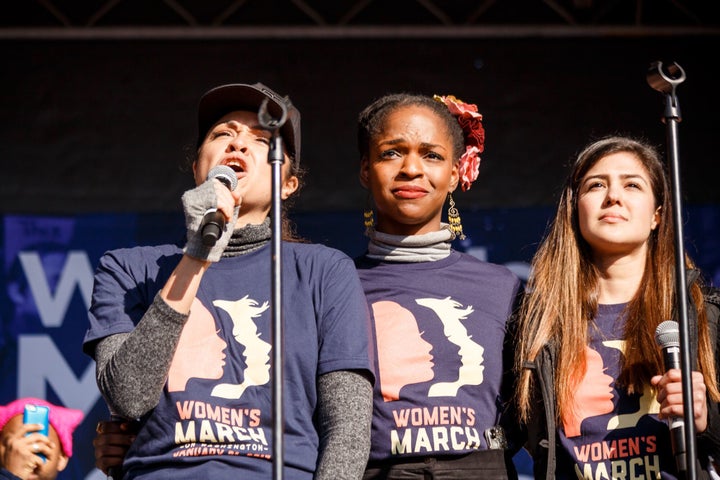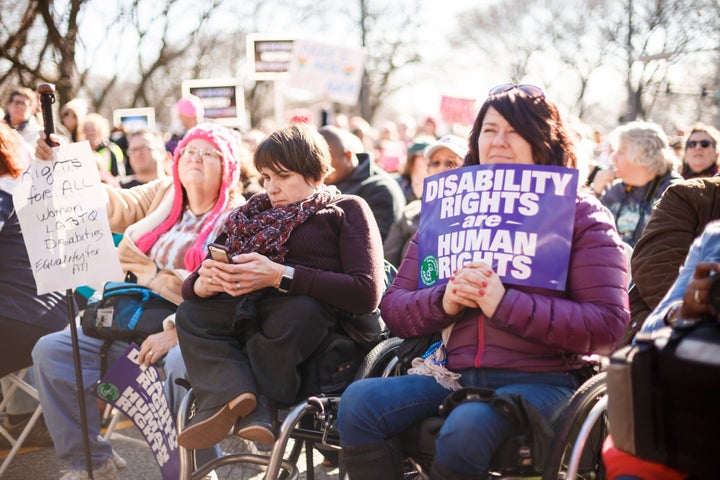
Sometime after the star-3 Doors Down-studded inauguration of now-President Donald Trump, millions of women gathered around the world to stand up to the administration’s pussy-grabbing, Muslim-registering, Russian-backing, Betsy DeVosing ways. Orwellian Press Secretary Sean Spicer may have boasted of the inauguration’s unprecedented unpresidented success, as it allegedly drew “the largest audience to ever witness an inauguration, period, both in person and around the globe,” but the Women’s March overwhelmingly surpassed the inaugural crowds, and has even been estimated to be the biggest protest in United States history.

Numbers seem to be on everyone’s mind – 2.9 million people, 30.6 million voters, hundreds of thousands of Metro trips, Nielson ratings and what looks like a million to a million-and-a-half people, Facebook groups growing from 20,000 to 50,000, and all these numbers scrambled into alternative facts, where two plus two equals five because an authority has dictated it to be so.
So, in the spirit of all the numbers, I present my first ever listicle, on my own three takeaways from this weekend’s march.
1. Optimism trumps pessimism.

Before Saturday’s festivities, I had the feeling that the march would be an intensely sad experience. This was partly related to the miasma of depression I’d been living under since the election: that cloud that descended over me like a grey cartoon bubble blunting my nerve-sharp feelings of panic and anger and confusion. An ambivalence numbed those around me too.
“What difference will it make anyway?” seemed to be the refrain.
The other end of the political spectrum also seemed to expect the protests to be a very un-joyous gathering of perpetually angry “femninazis” and liberal cry-babies. On Facebook and elsewhere, conservative voices bemoaned such negativity, and of course the protest’s threat to the rule of law. The videotaped window-bashing at the D.C. Starbucks even scared me enough to keep my toddler at home.
But then, there was the march, and it was like Obama’s “yes we can” echoing from his farewell speech ― from his first campaign ― now making its way across the city, country, world. It didn’t hurt that the day in Chicago was stunningly beautiful, January climate-changed into the late spring, fog rolling across Navy Pier and misting over the big-shouldered skyline so imprinted on my brain. My best friend, her mom, and I Ubered our way down Lake Shore Drive, donning gold-painted, fake-pearl-encrusted, metallic kitty ears. From the apartment to the streets to our long and winding adventure to find food post-march, we felt the city as one-in-many. Women at work who couldn’t march thanked those who did. Traffic-trapped drivers honked their applause, to the crowd’s glee. People laughed at each other’s shirts and signs. Cheers spread like a corny-synchronized, sport’s-game wave but without the synchronization, starting at random in the distance and electrically traveling from head to head.
Many of us even cried. Standing up the steps of Millennium Park and witnessing people coming together – realizing that together we -will- fight for the rights of women, and children, and Muslims. That even if certain politicians see us as fat slobs, or better off at home, or merely heads and limbs and breasts attached to genitalia: that even then, we know we are more. That we are not less than men, or more “emotional” or connected to Mother Earth: that we are human beings, flawed and rational and feeling just as much as the next person.
Our tears were the tears we yearned to spill on election night, refracted shards of the glass ceiling still standing overhead.

2. Creativity and diversity are the best and go hand in hand.
This really should go without saying, but with the elimination of the National Endowment for the Arts and Humanities, the privatization of NPR and PBS, and the administration’s general attitude towards minorities, Muslim Americans, and immigration in their warped dream of some white-faced, Leave It to Beaver-ish “great” America of the past, it is unfortunately worth restating.
Our country is great because of its diversity of peoples, cultures, and perspectives.
How boring would it have been to see one uniform slogan held by the same-looking person, with a matching pedigree and life experience to boot? [Hint, it would be something like the Trump rallies.]
Instead, at the march we saw a brilliant array of people, from all walks of life. Grandmas and infants, fathers and tweens. Hair bleached white and painted in turquoise, silver gleaming against jet black, headscarves, dreads, ponytailed and limp, shorn short, cradle-capped.
From these incredible women and allies came creative and powerful expressions of resistance and politics. The signs they carried were hilarious, biting, vulgar, stunning. VEGANS FOR VAGINAS. Home-drawn Trump caricatures making out with cheek-boned, sulky Putins. BLACK LIVES MATTER. Uteruses surrounded by tiny hands, or equipped with cylindrical bullets. Painted women, purple and blue and green. Black- and white-inked bodies with swirling curlicues. LOVE TRUMPS HATE, and Girls Just Want to Have FUNdamental rights. Portraits of Hillary, Ruth Bader Ginsberg, and Shepard Fairey’s Muslim American women draped in a brilliant red, white, and blue headscarf.
My protesting companions and I were not carrying signs, convinced that our arms would be tired, unaware of how fun that process would be: of how the display of minds creatively at play is the very power of our diverse democracy in action.
Of course, many have discussed the issues of diversity plaguing the movement’s planning and execution. If we are serious about fighting the vast injustices and corruptions of our country, we must continue to press for not just the inclusion of all voices and peoples, but for a revolutionary equality, one that will rip apart the blanket of white privilege that kept many of these same participants out of the Black Lives Matter movement.
It’s cheesy, and perhaps oozing of white feminist privilege to say it in these terms, but we will be stronger and more creative because of these differences.

3. Power will try to change the conversation.
So, the marches were peaceful, unifying, well-run, and wide-scale, trumping Trump himself: well, why weren’t these people at the election? Or: my inauguration was better attended than Obama’s. Or: the media is giving fake numbers, here are the real numbers.
It’s hard to fight clearly-stated facts and numbers. Saying something extreme and false and besides the point changes the conversation. Instead of talking about the chaos of scrapping ACA, or the loss of women’s rights in defunding Planned Parenthood, or the cringe-worthy Cabinet hearings, we get to talk about whether or not Trump’s inauguration was larger than Obama’s, or for that matter any other inauguration in the history of the United States. The absurd lie takes center-stage, along with all of our collective energy to dispel it. (Look at these numbers here, these images, these Metra tickets…)
So, yes, in this world of alternative numbers and facts, let’s fight fake news and deception with the truth. But also, let’s not engage with the petty gaslighting this administration engages in, like some would-be adulterous spouse, to distract us from what is important and what is real with their inane verbal abuse. It’s no surprise: they’ll continue to go low. Let’s go high.
